| Jul 26 |
Filled under: Events, Maze Running, Myths, legends, folklore, Readers, Research | by laridon |
I’m not long back from the most memorable and fun Maze Running event I’ve done yet.
I do thoroughly enjoy chatting to kids about books in libraries and bookshops, but the kind of event I love doing most is taking books and readers out into the real world, to talk about research, inspiration and imagination in the legendary locations where I actually set my adventures.
And yesterday, I climbed to the top of Dunadd, a rocky hillfort in Kilmartin Glen in Argyll, and read an ambush scene involving minotaurs, dragons, wolves, swords, axes, mice and some very odd rope, to more than thirty people in the bright sunshine, including a mix of readers from 6 year old girls to 13 year old boys.
It was wonderful! There is a tiny natural amphitheatre right at the top of the hill: a curve of Iron Age (I think) wall where I put my books and bottle of water, facing a slope of grassy hillside where all the readers and their parents sat. We were just above the carved footprint where Scottish kings were crowned many years ago, the footprint which was at the heart of the magic which drew me to set a scene at Dunadd.
And the audience were all fantastic! Dunnadd is, in the nicest possible way, in the middle of nowhere. Everyone had had to drive a significant distance to get there (one family had driven for at least 90 minutes to attend the event), everyone had to wear sensible outdoor clothes, and listen to a health and safety talk at the bottom, then climb up a rocky steep path to get to the top. So they were REALLY keen. That’s the best kind of audience!
Some of them even brought their dragons. A head count would have suggested five dragons, but as the orange one was two-headed, there were really four different cuddly or plastic dragons at the top of the hill. And someone brought a large white unicorn, which given the rescue scene at the start of Maze Running, was very appropriate!
So, surrounded by the sunlight and the rocks, with everyone having a view of the wonderful Scottish landscape all around us, I read the start of the quest on Dunadd, pausing a couple of times to point out that the dragon was parked just behind the lady from Kilmartin House Museum, then to say that the minotaur was holding his blackhandled axe in amongst the parents at the back and that the grey-legged faun was being nasty to a mouse where I was standing. It’s amazing to read a scene out loud exactly where I imagined it happening. It brings the characters and action to life, in a way which is almost magical.
Then I encouraged the children to imagine their own quests and adventures on Dunadd. We had a few dragon ambushes, some very sneaky treasure hunting, and a really unusual way of hiding a centaur. Everyone’s imaginations were sparking in the sunshine!
Then I told a myth which had come over to Scotland from Ireland, just like the kings of Dalriada who were crowned on Dunadd. I chose that myth because it allowed me to stab the wee boy reclining on the grass slope at the front with a particularly nasty spear.
But my favourite moment was when I described how the silent ambush tactic used by the minotaur was inspired by a snake I had seen on Dunadd on one of my research visits. When I said “snake” everyone in the audience jerked backwards, half stood up, or checked the grass under their bottoms, and they all looked extremely worried for a moment. (The adults looked much more worried than the kids!) So I had to say that I knew what kind of snake it was, and it was NOT poisonous, and anyway, we had seen it way over on the other side of the hill LAST YEAR.
No-one had worried about a fictional minotaur in their midst or a dragon behind them, but almost everyone reacted very speedily to a passing mention of an innocent snake! That’s something which never happens in a bookshop.
In previous years I’ve read from First Aid for Fairies at Tam Linn’s Well, Wolf Notes outside Dunvegan Castle, and Storm Singing in Smoo Cave, all of which were wonderful locations, but I think reading from Maze Running on Dunadd was my favourite outdoor event so far. Partly because of the incredible weather, partly because of the snake reaction, but mostly because of the huge effort all the readers made to get there and the wonderful dragons and ideas they brought with them.
Books. Hills. Kids. Stories. I have the BEST job in the world!
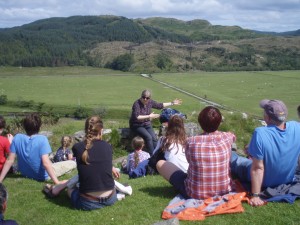 Maze Running event on Dunadd |
| Jun 20 |
Filled under: Events, Maze Running, Novels, Readers, Schools | by laridon |
We launched the fourth and final book in the First Aid for Fairies series last night. In a hot and crowded hall just off the Royal Mile (there were groups from at least 6 primary schools there!) we held a launch party for Maze Running.
But what is a book launch FOR? For readers it’s a chance to eat some crisps, and get a signed copy of the book before anyone else. For the publishers it’s a chance to let booksellers and buyers know the book is out there. And for the writer it’s a chance to thank all the people involved in turning a story into a book (and for Maze Running there were lots of thanks, including publishers, agents, early readers, my kids, vets… I hope I didn’t forget anyone last night!)
So a launch is really a hello to a book. A birth day birthday party, perhaps.
But last night was not just a hello. It was a goodbye too. Because Maze Running is the last in the series, I was saying goodbye to the characters and to the series. Which wasn’t easy. And quite a lot of readers in the signing queue asked me to write another one PLEASE! But I can’t write another First Aid for Fairies book. I stood up there and said to everyone: “This is the last time Helen will go on an adventure with the fabled beasts, to heal their injuries, at the solstices and equinoxes.” And while the word “last” in that sentence seems quite definitive, it might be possible to gallop a centaur through the wide gaps in the rest of the sentence…
However, several other readers in the signing queue mentioned that their favourite book of mine was Rocking Horse War, and wondered if I would write a sequel to that, now that I’m done with Helen. So that’s an idea I’m kicking about as well…
But right now, I’m not thinking about what I’m going to write next, I’m concentrating on saying hello to Maze Running, and goodbye to the fabled beasts.
So here are a few (slightly blurry) photos of the launch. Me reading to a small group of fabled beast fans, and a few favourite character pictures from Lorne Primary in Leith and Calderwood Lodge in East Renfrewshire.
Thanks to everyone who helped to launch Maze Running!
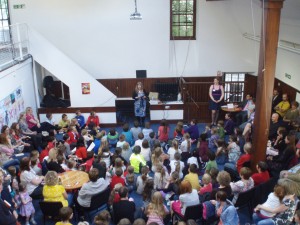 chatting to a handful of fabled beast fans 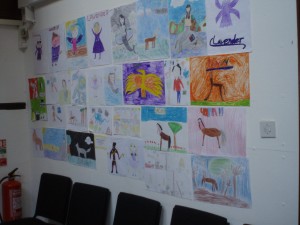 some of Lorne Primary's favourite characters 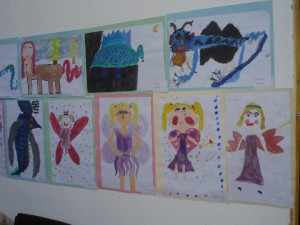 some of Calderwood Lodge Primary's favourite characters |
| Jun 08 |
Filled under: Events, Maze Running, Schools, Writing | by laridon |
I just looked at the very first folder for Maze Running, created when it was still called First Aid Four, and when I was working on each chapter individually, rather than in one big manuscript.
Looking at the names of the chapter files, you would think that I never sat at my own desk:
- One chapter was started in a primary school staffroom (Chap 6, Priorsford)
- Another was started in a primary school general purpose room between author events (Chap 17, Troon)
- At least three were written on long train journeys
- One was started in a train station in Lanarkshire when I on got the wrong train and was stuck in a waiting room for a couple of hours
- One quest was completed on the platform at Dundee train station
- One chapter was written in a hotel when I was doing a book festival in the North of England (Chapter 20, Durham)
- One was written in a B&B in Gairloch, in the far north west
- Another was finished in a guest house in Wigtown, in the far south west
- One was started at Meadowbank Stadium in Edinburgh
- “Chapter 11, Mitchell” suggests that I injured a dragon in the Mitchell library (quietly!)
- Three different chapters are titled “ballet” because I started them sitting on cold steps outside my daughter’s ballet class.
- And another is called “Argyll quest at ballet exam” because I wrote part of the fourth quest while my daughter was sitting a ballet exam. (She passed. Helen and the fabled beasts didn’t do quite as well!)
In Maze Running, I send Helen and the fabled beasts on seven different quests, missions and rescues, to the south, north and west of Scotland. But I’ve realised that the book was written in even more places than that!
So, does this mean I spend too much time away from my desk? Am I not taking my writing seriously enough? I don’t think so, because I don’t need a desk to write – I just need my netbook, or a pen and a bit of paper. Or I can even just scribble on my other hand, or a napkin…
Does it mean I’m only inspired to write when I’m out and about, rather than at my desk, and should get out more often? I don’t think that either! I write a lot at home too, but because I’m not transferring those files from one computer to the other, I don’t give them such detailed names.
It really just means that my three jobs – being a writer writing, being a writer talking about writing and being a mum – are all part of the same life, rather than neatly separated. So I take whatever book I’m writing with me everywhere I go, and write it wherever I can.
It also shows that I can have really good ideas when I’m sitting outside a ballet class, or in a cold train station. Even if I am typing with gloves on.
I write fast-moving action and set my books all over Scotland, so writing on the run and in lots of different places is probably very good for my stories. And I write for 8–12 year olds, so working out how I’m going to start the next chapter just after speaking to P5 about cliff hangers and just before speaking to P6 about chase scenes, is probably the best way to write!
I wonder where I’ll write the next book?
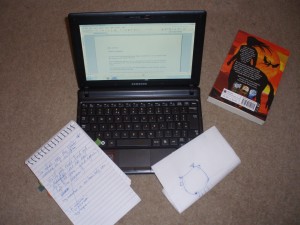
tools for writing on the run: netbook, notebook, napkin
|
| May 22 |
Filled under: Maze Running, Novels, Readers, Writing | by laridon |
It’s less than a month until the launch of Maze Running, the fourth and final book in the First Aid for Fairies series.
The fourth and FINAL book.
And right now, I’m asking myself: Why is it the final book? This is a successful series, with lots of fans, with recognisably stunning covers, set in a world where I could easily have found dozens more adventures. So why have I stopped?
Was I bored? (No! I love this world and these characters.)
Did my publishers say, nah, that’s enough thanks. (Not to me…)
Was I running out of readers? (Nope, not that either!)
So why, as a new-ish writer, trying to build a career as a real proper writer, have I stopped writing a successful series?
It’s a bit daft, really. I have strong characters I enjoying working with, and a formula which could repeat endlessly in different parts of Scotland, with different baddies and different magic.
But that’s really the point: I don’t want it to become a formula. I want each of my books to be original and different, not to feel tired and samey. And while I don’t think I was anywhere near that with the First Aid series, I suspect I would have got there before I hit double figures! So I wanted to stop while the books were getting steadily stronger and more exciting.
Some of my readers are a bit upset, even politely annoyed, that I’m ending the series here, but actually that’s quite good (sorry!) because I want to leave you wanting more. Perhaps you’ll go on to make up your own stories set in the fabled beasts’ world. I also hope you’ll wait eagerly for whatever I write next…
Another major reason for ending the series here is that my characters kept growing up. Because I have been very specific about each adventure’s time of year, there have been months between each book, and Helen and her friends are now all more than a year older than they were in First Aid For Fairies And Other Fabled Beasts. If I kept writing about them for another few months, and honestly reflected their lives and concerns, I wouldn’t be writing for 8-12 year olds, I’d be writing for teenagers, which I’m happy to do, but not within this series.
Also I don’t want to get too comfortable with these characters, nor do I want to tread the same paths with them again. I know them really well, and I’ve taken several of them on tough emotional journeys, as well as dangerous quests. I don’t want to artificially push them backwards just so we can watch them develop all over again. (Yes, Yann, I’m talking about you. And Lee and Rona, and maybe even Helen.) I want to meet and work with NEW characters. Though I really am going to miss these ones.
I don’t want to be pigeonholed as a writer either. I want to write lots of different kinds of books (which I’ve possibly achieved already with picture books, retellings and teen novellas.) But I want to write other novels too – my only standalone novel Rocking Horse War sometimes gets a bit lost amongst Helen’s adventures, so I want to concentrate on other ideas like that for a while.
So, sorry to all the First Aid for Fairies fans out there. No more books about Helen healing her fabled beast friends at specific seasons of the year.
This is the end.
But I think it’s best to go out with a bang!

And here’s the cover of Maze Running. What do you think?
|
| May 02 |
Filled under: Novels, Picture Books, Readers, Writing | by laridon |
I’m sitting on the fence today, not sure if I’m a picture book author or a novelist. I launched my new picture book, Orange Juice Peas, at the end of April and I’m already starting to think about the launch of Maze Running in June. So I’m going to spend the month of May being a wee bit confused about who I am. Do I write books about peas, bananas, babysitters and giggling, or do I write books about monsters, magic, danger and quests?
The answer of course is that I do both, often on the same day, and that I only occasionally get confused. But why do I do both? And is there any difference, for a writer, between them?
The main difference for me is that I spend so much time with the characters in a novel, often months, sometimes years, that I know them as well as my family and friends, and care about them almost as much too. I don’t spend nearly as long with the characters in a picture book, so however fond I am of them I don’t know them as well. In fact, I don’t really know them at all until I see their pictures. That feels like the moment I first meet them, which can be a year or so after I write the book!
Also, I don’t have to describe the characters in a picture book, or everything that they do, because the reader can see them on the page (I may have described the characters and the action in illustrator’s notes when I came up with the idea, but those notes aren’t part of the finished book.) In a novel I have to give the reader a lot more detail, because the reader has to make the pictures of the characters and the action in their mind (the very best kind of pictures, I think!)
And the words in a picture book are still a work in progress until they are married with the pictures, because the illustrations are just as much a part of the story as the text. The cover of a novel, however, is designed to draw you into the story, it’s not part of the story.
And why do I write both? Because I always want to find the best way to tell a story. When a “what if” pops into my head, I want to explore it in the best way for that question. If the question is about whose bottom this is, or who is going to eat what ice-cream, then it’s probably a picture book; if the question is about why someone has just kidnapped your brother and sisters to use in a magic spell, or why there’s a thieving jellyfish trying to strangle a camp full of scouts, it’s probably an adventure novel! Also if there is only one problem to solve it’s probably a picture book, if there are lots of problems it’s probably going to take a bit longer!
So it’s usually clear to me whether a story idea is a novel idea where I will build the pictures for the reader to see, or whether it’s a picture book idea where I build the structure for an artist to create the pictures.
So, picture books and novels look very different on the shelf, and they are quite different for the writer too. And right now I have a picture book idea AND a novel idea in my head. Which should I go and scribble down first?
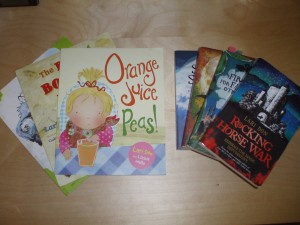 picture books vs novels! Here are all my picture books and all my novels so far. They do look quite different! Which pile looks more fun to write?
|
| Apr 17 |
Filled under: Events, Picture Books, Readers, Schools | by laridon |
I’m quite excited! My tenth book (ten books, in four years!) will be published this week. Orange Juice Peas is about a little girl called Jessie, her big brother Ben and a very messy teatime. And it has wonderful bright cheery pictures by Lizzie Wells.
Even though Orange Juice Peas isn’t in the shops yet (it should be available at the weekend) I already have a copy which I’ve sneakily read to a few groups of children.
Reading a new picture book out loud to children for the first time is a strange experience. It’s not the same as reading a carefully selected cliffhanger extract from a novel to 9 year olds. Reading a whole picture book to group of 5 year olds, especially for the first time, feels quite risky. What if they won’t sit quiet and listen? What if they get bored and wander off, or start picking their noses, or asking to go to the toilet, or poking the child sitting beside them? What if they don’t like it? (These are very small children, remember, and if they don’t like something they might not be polite about it!)
So I get quite nervous the first few times I read a picture book to an audience. It’s my first chance to see if the story works. I do read a book out loud to myself when I’m drafting it, and to my own kids when I think it’s finished. But the book doesn’t feel real until I read it to kids I don’t know, to see what they think, to see how they react, and to find out the most important thing: will they laugh at the right bits?
I’m delighted to say that yes, the couple of times I’ve read Orange Juice Peas to kids – in Selkirk and in Falkirk – they have laughed. At the bits I hoped they’d find funny, and at other bits as well!
Also, some of them went “aww” at the right bit near the end too. And some of them tried to count the peas on the pages where the editor, designer and I had spent hours checking the numbers of peas (so Sally and Helena, that was totally worthwhile!)
Now I am ready to take this book out into the world, because it seems to work. (Phew.) And that’s something you can never be sure of, whether it’s your first book, your third book, your tenth or your hundredth, until you actually know what the readers think of it!
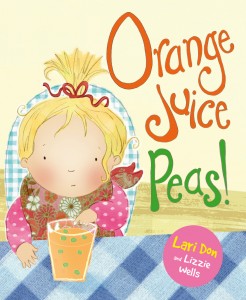 Orange Juice Peas |
| Mar 26 |
Filled under: Maze Running, Novels, Writing | by laridon |
I’m just recovering from the most emotional edit I’ve ever done.
Normally edits are about reducing wordcounts, tightening language, cutting repetition, checking facts, filling in plotholes, and generally telling the story in the best way possible.
And yes, that is what I’ve just done with Maze Running. I found some silly mistakes (I sent a dragon called one name off on a quest, and brought a dragon with a different name back! It’s ok, I noticed and sorted it) and I found a few last minute plotholes (one of which I covered up, literally, with a cloak – handy things cloaks.) I replaced weak wobbly words, made sentences clearer and took out dialogue that wasn’t necessary for the story. I also made a few tweaks to answer questions from my editor. She’s excellent at noticing things which I don’t explain clearly enough, or explain far too often, or which I can’t explain because they don’t make any sense.
By the time I sent the manuscript away a few days ago, it was shorter, clearer, faster and more exciting than the draft I finished at the end of last year. So the editing went really well.
But I was miserable. Actually (and don’t tell anyone this) I was sniffing, wiping my eyes and blowing my nose a lot.
Why? I’m happy with the story and I’m excited about sharing it with people. So why was I sad and upset?
One reason is because my relationship with a book alters once it’s sent off to the printers. I always find it a bit weird reading the printed version of my novels, because I can’t change them any more. If I suddenly think of a different way to express what’s happening, I can’t do it. I have no power over the story any more. I’m not really the writer any more. Just the person who wrote it.
So the final edit is slightly terrifying, because it’s my last chance to get it right. My last chance to spot mistakes, but also my last chance to do the story and the characters justice. Once I’ve sent it away, that’s it. I can’t make it any better. So that’s why the last edit of every book is nerve-wracking.
But with Maze Running the emotional wrench was ever harder. Maze Running is the fourth and FINAL book in the First Aid series. This book is the last adventure I will write about Helen, Yann, Lavender, Rona, Sapphire, Catesby, Lee and the rest all together.
If you think you’re upset about that (and I’ve already met readers who are a little bit annoyed with me for ending the series! But I’ll explain why I made that decision in another blog post soon…) So if you think you’re upset, just imagine how upset I am. I’ve spent more than five years of my life with these characters. I know them better than most people I meet in the real world. I hear their voices in my heads. I put them in terrible situations (worse situations in this next book than any other, sorry guys) and I trust them to get back out again. I work with them, listening to their reactions, letting them guide and sometimes even change the story. And now I’m done. Now I won’t write about them ever again, not as a group, not in this way, maybe not in any way at all.
And it was my decision. I feel like I’ve left them. Which makes me feel sad, guilty and almost like I’m grieving.
I know I will read their adventures out loud at book festivals and in author events. I will read the cliff-hangers, the quests and the fights. But because I won’t be able to change one word of what’s on the page, then I won’t be writing them any more. I’ll be reading them instead.
First Aid for Fairies was my first book. I owe these characters a lot. I really enjoy being with them. And when I handed the manuscript to Floris earlier this month, I was saying good bye to them.
That’s why this edit was highly emotional, and very sad. But also very exciting. Because who knows what I’ll write (and then edit) next…
|
| Mar 05 |
Filled under: Events, Research, Schools, Writing | by laridon |
I’m in the middle of lots of school visits around World Book Day, which you’d think would only last a ‘Day’ but seems to last at least a fortnight!
One of the best things about lots of school visits is lots of great questions from pupils. I answer questions at the end of every session, so I probably answer dozens of questions a week, possibly even hundreds a week at this time of year.
What amazes me is I’m still being asked new, original and surprising questions. There are questions which come up pretty much every time (when did you become a writer, how many books have you written, what’s your favourite book?) but I’m impressed that kids are still asking questions which I’ve not heard before, questions which make me think hard about my writing process.
The best question I got on World Book Day was from a pupil at Stockbridge Primary in Edinburgh, who asked: “What’s more important for a writer, imagination or knowledge?” I thought that was fascinating, because creative writing teaching often concentrates entirely on imagination, but a story won’t be convincing if it’s full of errors. On the other hand, if you have lots of facts, but no flash of inspiration bouncing off the facts, then you haven’t got a story. I came to the conclusion that both imagination and knowledge are vital, but that I start with imagination then fill the gaps with research. New writers are often told to “write what you know” but if I only wrote what I know, then I’d write boring books about making packed lunches. Instead I allow myself to imagine stories about injured centaurs or living rocking horses, then I research the time or place or biology and write about the NEW stuff I know.
Another question I was asked recently at Westercommon Primary in Glasgow was: “How do you know when a story is finished?” That’s a brilliant question, because we spend a lot of time thinking about good ways to start stories, and we may not think hard enough about how to finish them. I explained that my stories are finished when my characters have solved the main problem. Because it isn’t a story without a problem: a mystery, a quest, a baddie to be defeated. You spend the story trying to solve the problem, and once it’s solved, the story is over. Boom. The End.
A pupil at St Mary’s in Glasgow asked: “When you reach a certain age, will you want someone else to continue your work?” That made me laugh, because I never want to reach a certain age… But the serious point we discussed was whether someone else could carry on my work, indeed any writers’ work, or whether it’s individual to us. If a person’s life work is campaigning for animal rights, or planting a forest, or running a jam factory, someone else probably could continue it, but no-one else could write my stories. Not exactly the way I write them. Because my stories come out of my thought processes, my experiences, my way of research, and my own individual (hard to explain and impossible to replicate) flashes of imagination. That’s the magical thing about writing: we all write differently. So no, if I ever reach a certain age and stop writing, that will be it. No more Lari Don books. I’d better get a move on and write another one while I still can!
I’ve been asked other fascinating questions in the last few weeks, but my author events are noisy and fast moving, so I don’t often remember the exact questions afterwards. If you asked an original question which I’ve not mentioned – sorry!
And if you can come up with a question which you think no-one has ever asked me before, please do ask it! You don’t have to wait until next World Book Day or until I visit your school, just post a comment here or email me on: info@laridon.co.uk
And if any other writers want to share the best or most original questions they’ve been asked, I’d love to read them!
|
| Feb 16 |
Filled under: Heroines and heroes, Novels, Research, Writing | by laridon |
My new novella, Drawing a Veil, is about a girl who decides to wear a headscarf to school, and her friends’ and classmates’ reaction to that decision.
I’m fascinated by the idea of choice, and how we deal with the awkward fact that if we support people’s right to make free choices, then we also have to support them when they make a choice we may not agree with.
Writing this book did make me feel uncomfortable at times, and I know it made a few of my feminist friends uncomfortable too.
So is it a good idea to write about something which makes you feel uncomfortable or challenges the comfy assumptions you don’t question often enough?
If I only wrote about decisions which I agreed with, if I only wrote stories which I felt happy and warm and cosy writing, then I probably wouldn’t write anything worth reading. (A lot of Helen’s risk-taking in the First Aid series, for example, makes me VERY nervous as a mum!)
So, even though I’m an atheist, who would never cover any bit of me up to please a god I don’t believe in, I realised that if I want the right NOT to wear a headscarf, then I also have to stand up for other people’s right to wear headscarves if that’s what they want. (And of course, any girl’s, or any woman’s, right not to cover up if she doesn’t want to.)
Also I think there’s an assumption that all girls in veils or scarves are shy, unsure of themselves, hiding themselves. But when I talk to kids in schools about imagination and creativity, I see absolutely no difference in their levels of confidence or self esteem, whatever the girls are wearing on their heads. So I really wanted to write about a girl in a headscarf who stands up for herself, who takes part in an argument, a fight and a chase (because action is what I enjoy writing!)
This isn’t the first time I’ve written about subjects which make me uncomfortable or make me question my own assumptions. In both Wolf Notes and Rocking Horse War, I’ve written about hunting and hunters, even though I’ve been a strict vegetarian since I was 14. So writing about wolves hunting deer, or girls tracking deer (poor deer are victims in a few of my books!) made me question my own reasons for being vegetarian. When I was researching wolves and how hunting led to their social networks and their intelligence, I seriously considered becoming an omnivore again, because that’s what humans evolved to be. But after reflection, I decided my reasons for being vegetarian were more than just a long lasting fit of teenage pique, so I am still a proud veggie.
But the point is that I write about characters who believe very different things from me, and I allow those characters and their stories to make me examine my own beliefs. I think that’s a very good thing. For the characters, for the stories and for me.
And how did spending time with Amina in Drawing a Veil change my comfy assumptions? Writing about this confident girl and her decisions made me realise that a freely taken decision to wear a headscarf can be a positive assertion of identity, rather than a passive adherence to family or religious pressure.
So – what beliefs or assumptions of yours could do with being taken out and examined by stories, characters and tough questions?
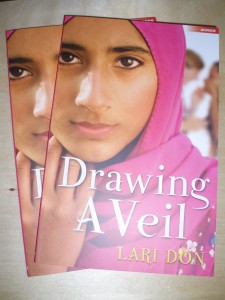 Drawing a Veil cover |
| Feb 02 |
Filled under: Maze Running, Novels, Writing | by laridon |
I’ve chosen names for two children, and both times it was a lot easier than naming my next novel!
Titles are sometimes very easy to find. Some of my books have arrived in my head with titles almost fully formed. I had the idea, I thought ‘oh, that could be a book!’ and by the time I’d reached for a notebook to start scribbling the idea down, I already knew what title to put on the cover.
For example, Rocking Horse War and How to Make a Heron Happy were always the titles of those books. I never considered anything else.
And the title First Aid For Fairies And Other Fabled Beasts arrived very fast too. Though to be fair, I always expected someone (my mum, my agent, the publisher) to say, ‘don’t be daft, please come up with something shorter!’ But no-one did; everyone seemed to like it. And it does describe the story pretty well!
However, it did leave me with a bit of a problem, which is that the title of every subsequent book in the series has to have the structure:
Something Something and other Something Somethings. Whew.
This has posed problems for every book. Wolf Notes as a title didn’t appear until I was about 2/3 of the way through the book. I knew I wanted ‘wolf’ or ‘fangs’ in the title, but didn’t know what else, until my husband found the phrase ‘wolf notes’, which I loved because it fitted the feel of the book. Though I have to admit that I went back through the story and changed a few bits of the plot to make the title fit perfectly.
Which poses an interesting question: do you write a different story if you already know the title? Do you write the story to FIT the title? Is it better to wait until the end of the plot-building to come up with a title, so you aren’t pinned down by the title, or is it better to know the title at the start so you can keep the story focussed? I’m not sure – I’ve done both, and both ways have worked for me with different books. And of course, sometimes a writer will think they know the title of a book, but the editor will disagree, so the title changes at the last minute! (In which case, can the title ever really fit the book?)
Storm Singing was a title I liked right from the start of the writing process, and I agreed it with the editor early on – we even had the tricky second part (And Other Tangled Tasks) sorted too. So writing the book and that title went hand in hand, which meant the idea of Storm Singing was a vital part of the plot from the start.
But now I’m working on the fourth First Aid book. And this time I wrote the whole plotline with no idea what the title was going to be. I had a few ideas, but none fitted perfectly, and the ones I liked best my editor didn’t like at all. So I finished the story, and started to edit it, still with no idea what the title was going to be. This felt very weird, because I had little signposts in the book to various potential titles, and I didn’t know which were going to stay in and which were going to come out.
Then only two weeks ago, I came across a phrase which was PERFECT! It fitted the story, it even added another layer which I hadn’t anticipated, and it sounded great! And not only that, my editor likes it too.
So… I can now announce that the title of the fourth and final First Aid for Fairies book is:
Maze Running And Other Magical Missions!
What do you think? Please let me know…
|
|
|

I’m children’s writer, and I write this blog mainly for children – readers, young writers, school classes, book groups etc, who want to understand how a writer writes. Everyone else welcome too though! And please do comment if you have any questions, or want me to blog about anything specific.
|










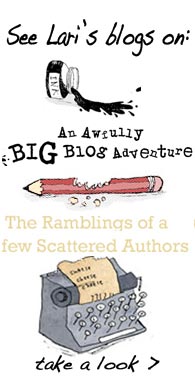
Recent Comments